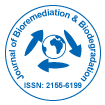Our Group organises 3000+ Global Conferenceseries Events every year across USA, Europe & Asia with support from 1000 more scientific Societies and Publishes 700+ Open Access Journals which contains over 50000 eminent personalities, reputed scientists as editorial board members.
Open Access Journals gaining more Readers and Citations
700 Journals and 15,000,000 Readers Each Journal is getting 25,000+ Readers
Google Scholar citation report
Citations : 7718
Journal of Bioremediation & Biodegradation received 7718 citations as per Google Scholar report
Journal of Bioremediation & Biodegradation peer review process verified at publons
Indexed In
- CAS Source Index (CASSI)
- Index Copernicus
- Google Scholar
- Sherpa Romeo
- Open J Gate
- Genamics JournalSeek
- Academic Keys
- JournalTOCs
- ResearchBible
- China National Knowledge Infrastructure (CNKI)
- Ulrich's Periodicals Directory
- Access to Global Online Research in Agriculture (AGORA)
- RefSeek
- Hamdard University
- EBSCO A-Z
- OCLC- WorldCat
- SWB online catalog
- Publons
- Geneva Foundation for Medical Education and Research
- MIAR
- ICMJE
Useful Links
Recommended Journals
Related Subjects
Share This Page
Copper biosorption: Influence of biomass particle size
Joint Event on 12th World Congress on Biofuels and Bioenergy & 13th Global Summit and Expo on Biomass and Bioenergy
Nancy Quaranta
Universidad Tecnologica Nacional, Argentina
Posters & Accepted Abstracts: J Bioremediat Biodegrad
Abstract
The heavy metals found in wastewater discharges generate serious environmental and health concerns. In recent years, there have been numerous studies based on the removal of heavy metal ions from aqueous solutions using lignocellulosic materials, which are capable of adsorbing various pollutants at low concentrations. The biomass under study in this work, which is used as a biosorbent of heavy metals, are peanut shells. The present work is oriented towards the study of the influence of biomass particle size on the copper adsorption process. For this purpose, the peanut shells were ground, separated in four different ranges of particle sizes (<1000 m, 1000-250 m, 250-88 m, 88-44 m). This biomass was analyzed by various techniques to determine its physicochemical and environmental characteristics: SEM-EDS, XRD, DTA-TGA, FTIR, pH, ecotoxicity, SBET, among others. Adsorption tests were carried out in batch, placing 100 ml of solution of known Cu++ concentration in contact with 5 g of biomass and shake for 2 hours at 180 rpm. The obtained dispersion was filtered and the concentration of the Cu++ ion in the solution was measured. The results obtained as a percentage of copper removal were 20.8 for the <1000 m size, 17.6 for the 1000-250 m size, 41.5 for 250-88 m size and 33.9 for 88-44 m size. It can be seen that the biosorption processes proved to be much more efficient for particle sizes less than 250 m. These results are related to the information obtained by the characterization of the BET surface of the samples. The figure 1 shows the SEM images of the peanut shells used, and the fibrous structure of this material. Recent Publications 1. I. Morosanu, C. Teodosiu, C. Paduraru, L. Tofan (2017) Biosorption of lead ions from aqueous effluents by rapeseed biomass, New Biotechnology, 39 [A] 110-124. 2. L. Djemmoe, T. Njanja, M. Deussi, D. Tonle (2016) Assessment of copper (II) biosorption from aqueous solution by agricultural and industrial residues, Comptes Rendus Chimie, 19 [7] 841-849. 3. N. Quaranta, M. Caligaris, G. Pelozo, A. Césari, A. Cristóbal, (2018) Use of wastes from the peanut industry in the manufacture of building materials. Int. J. Sus. Dev. Plann. 13 [4] 662-670.Biography
Dr. Nancy Quaranta obtained her Ph.D. in Chemistry at the National University of South (UNS-Argentina). She is a researcher of the Scientific Research Commission of Buenos Aires Province. She is the head of Environmental Studies Group and Materials Program Coordinator at the National Technological University. Her current research fields are materials and environmental sciences. She is author of numerous publications and presentations at international congresses. In the last years, her work has been oriented to the study and valorisation of industrial wastes, in particular residual biomasses of the agroindustry.
E-mail: nquaranta@frsn.utn.edu.ar

 Spanish
Spanish  Chinese
Chinese  Russian
Russian  German
German  French
French  Japanese
Japanese  Portuguese
Portuguese  Hindi
Hindi 
